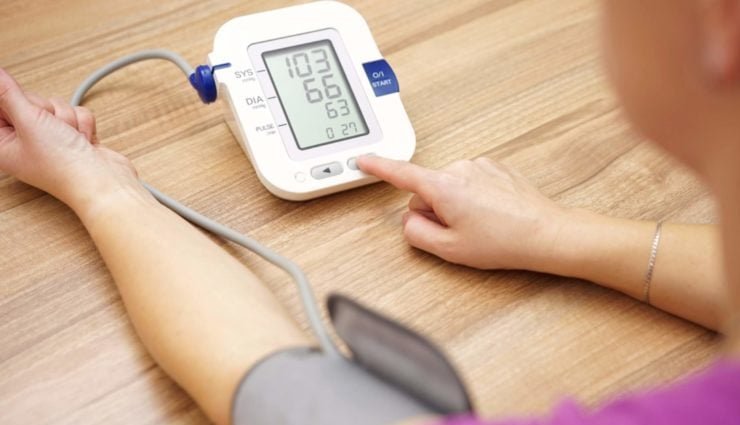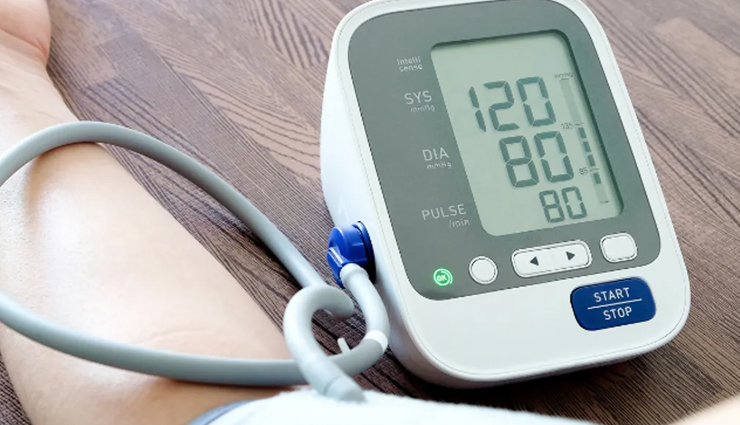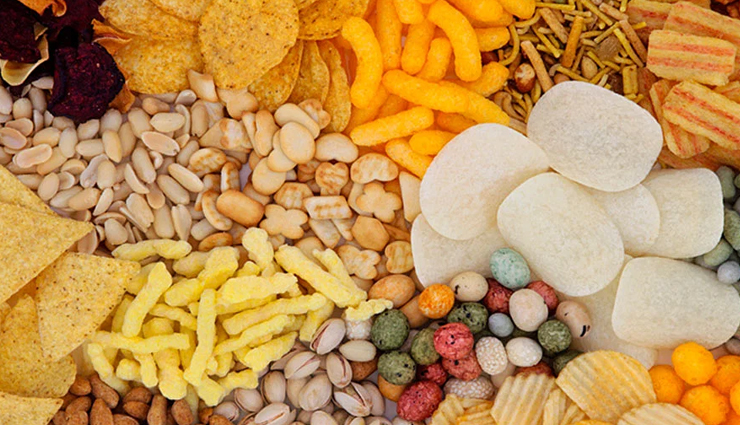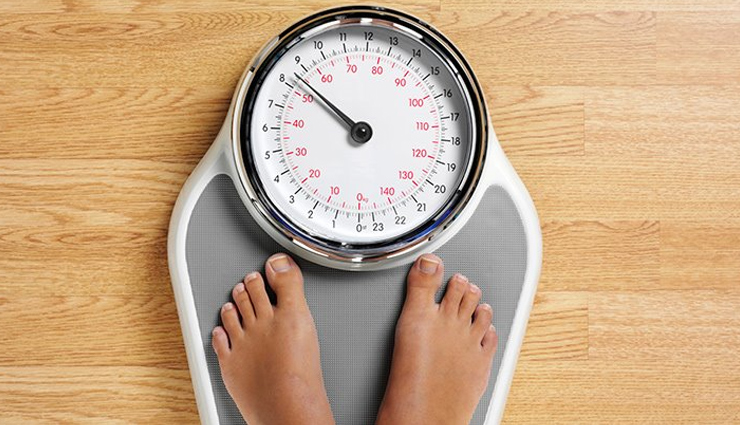- Home›
- Healthy Living›
- 10 Effective Tips To Control Hypertension And Maintain Healthy Blood Pressure
10 Effective Tips To Control Hypertension And Maintain Healthy Blood Pressure
By: Pinki Fri, 19 May 2023 11:16:55

Hypertension, or high blood pressure, is a common condition that affects millions of people worldwide. If left unmanaged, it can increase the risk of serious health problems such as heart disease, stroke, and kidney disease. Fortunately, there are various lifestyle changes and strategies that can help you control hypertension and maintain healthy blood pressure levels. In this article, we will explore 10 effective tips to help you manage hypertension and promote overall cardiovascular health.

# Monitor Your Blood Pressure Regularly
Monitoring your blood pressure regularly is an essential part of managing hypertension and ensuring optimal cardiovascular health. By keeping track of your blood pressure readings, you can stay informed about your current levels and make informed decisions regarding your lifestyle and treatment plan.
Here are some key points to consider when monitoring your blood pressure regularly:
Obtain a Reliable Blood Pressure Monitor: Invest in a quality home blood pressure monitor that is validated for accuracy. Automatic digital monitors are commonly used and provide convenient readings.
Follow Proper Measurement Techniques: Learn the correct technique for measuring your blood pressure. Sit in a comfortable position with your feet flat on the floor and your arm supported at heart level. Make sure you are relaxed and avoid talking during the measurement.
Take Multiple Readings: For more accurate results, take multiple readings at different times of the day. Blood pressure can fluctuate throughout the day, so taking readings at different times can provide a more comprehensive understanding of your blood pressure patterns.
Record Your Readings: Maintain a blood pressure log to track your measurements over time. Note the date, time, and the readings for both systolic (top number) and diastolic (bottom number) pressures. This log will help you identify any trends or changes in your blood pressure.
Regularly Review and Adjust: Regularly review your blood pressure log and discuss your progress with your healthcare provider. They can assess the effectiveness of your current treatment plan and make any necessary adjustments to help you better manage your blood pressure.

# Follow a Balanced and Nutritious Diet
Adopt the Dietary Approaches to Stop Hypertension (DASH) eating plan, which emphasizes fruits, vegetables, whole grains, lean proteins, and low-fat dairy products. Reduce your intake of sodium (salt), saturated fats, and processed foods, as they can contribute to high blood pressure. Incorporate a variety of fruits and vegetables into your meals and snacks. They are rich in essential vitamins, minerals, and fiber, which contribute to overall cardiovascular health. Aim for at least five servings of fruits and vegetables per day.
Opt for whole grains instead of refined grains. Whole grains such as brown rice, whole wheat bread, quinoa, and oats are high in fiber and nutrients. They help regulate blood pressure and promote healthy digestion. Aditionally Incorporate lean protein sources into your diet, such as skinless poultry, fish, beans, lentils, and tofu. These protein options are lower in saturated fat and can contribute to maintaining healthy blood pressure levels. Include potassium-rich foods in your diet, such as bananas, oranges, spinach, sweet potatoes, avocados, and tomatoes. Potassium helps counteract the effects of sodium and regulate blood pressure. Drink an adequate amount of water throughout the day. Staying hydrated helps maintain proper blood circulation and supports overall cardiovascular health.

# Limit Sodium Intake
Limiting sodium intake is crucial for managing hypertension and maintaining healthy blood pressure levels. Excess sodium in the diet can contribute to fluid retention and increase blood pressure. Here are some key points to consider when it comes to reducing sodium intake for hypertension:
Read Food Labels: Pay attention to food labels and choose products with lower sodium content. Look for "low sodium," "reduced sodium," or "no added salt" options. Compare different brands to select the ones with the lowest sodium content.
Cook Fresh Meals: Prepare meals from scratch using fresh ingredients whenever possible. This allows you to have better control over the amount of sodium in your dishes. Limit the use of packaged seasonings, sauces, and condiments, as they tend to be high in sodium.
Use Herbs and Spices: Enhance the flavor of your meals with herbs, spices, and other seasonings instead of relying on salt. Experiment with herbs like basil, oregano, thyme, and spices such as turmeric, cumin, and paprika to add flavor without adding sodium.
Be Cautious with Condiments: Many condiments, such as ketchup, soy sauce, and salad dressings, are high in sodium. Opt for low-sodium or sodium-free versions, or consider making your own healthier alternatives at home using fresh ingredients.
Minimize Processed and Packaged Foods: Processed and packaged foods often contain high levels of sodium. Limit your intake of items such as deli meats, canned soups, instant noodles, and snack foods. Instead, choose fresh, whole foods that are naturally lower in sodium.
Rinse Canned Foods: If you use canned foods, such as beans or vegetables, rinse them thoroughly under running water before consuming. This helps reduce the sodium content by removing excess salt used in the canning process.
Choose Fresh or Frozen Produce: Opt for fresh or frozen fruits and vegetables rather than canned varieties, as they tend to have added sodium. If using canned vegetables, choose those labeled as "no salt added."
Cook at Home: When you cook at home, you have better control over the ingredients and sodium content in your meals. Prepare meals using fresh ingredients and limit the use of salt during cooking. Instead, season dishes with herbs, spices, and other flavorings.
Be Mindful of Hidden Sodium: Some foods may contain hidden sodium, even if they don't taste salty. These include processed meats, cheese, bread, and certain breakfast cereals. Check the nutrition labels and choose lower sodium options whenever possible.
Gradually Reduce Sodium: Gradually reduce your sodium intake over time to allow your taste buds to adjust. Start by cutting back on processed and high-sodium foods and gradually decrease the amount of added salt in your cooking and at the table.

# Increase Potassium-Rich Foods
Increasing potassium intake is beneficial for managing hypertension and promoting healthy blood pressure levels. Potassium helps counterbalance the effects of sodium, relaxes blood vessel walls, and supports proper fluid balance in the body. Here are some key points to consider when it comes to incorporating potassium-rich foods into your diet for hypertension:
Include Fruits: Incorporate potassium-rich fruits into your daily diet. Good options include bananas, oranges, apricots, kiwi, cantaloupe, and strawberries. These fruits not only provide potassium but also offer other essential vitamins and minerals.
Consume Vegetables: Add a variety of vegetables to your meals to boost your potassium intake. Excellent choices include leafy greens like spinach and kale, tomatoes, broccoli, sweet potatoes, Brussels sprouts, and avocados.
Enjoy Legumes: Legumes such as beans, lentils, and peas are excellent sources of potassium. They are also high in fiber, which can help lower blood pressure. Consider adding chickpeas, kidney beans, black beans, or lentils to your salads, soups, or main dishes.
Choose Potassium-Rich Proteins: Opt for protein sources that are also high in potassium. Some examples include fish like salmon and tuna, lean poultry like chicken and turkey, and nuts and seeds such as almonds, pistachios, and chia seeds.
Go for Dairy or Dairy Alternatives: Dairy products like yogurt and milk are not only good sources of calcium but also provide potassium. If you prefer dairy alternatives, look for options fortified with calcium and potassium.
Enjoy Whole Grains: Whole grains like quinoa, brown rice, and whole wheat bread are not only nutritious but also contain potassium. They provide a healthy base for your meals and snacks while contributing to your potassium intake.
Consider Potassium-rich Snacks: Snack on potassium-rich foods to boost your intake throughout the day. Examples include dried fruits like raisins or apricots, unsalted nuts, and seeds like pumpkin or sunflower seeds.
Add Potassium-rich Herbs and Spices: Certain herbs and spices are good sources of potassium. Include ingredients like parsley, basil, turmeric, and cinnamon in your recipes to enhance flavor and increase potassium intake.
Be Mindful of Cooking Methods: When preparing potassium-rich foods, choose cooking methods that retain the nutrient content. Steaming, grilling, roasting, or consuming fruits and vegetables raw can help preserve their potassium levels.
Balance Potassium with Sodium: While increasing potassium intake is important, it's equally crucial to balance it with low sodium intake. Limit your consumption of high-sodium processed foods and be mindful of added salt during cooking and at the table.

# Maintain a Healthy Weight
Maintaining a healthy weight is crucial for reducing the risk of hypertension and managing existing high blood pressure. Excess body weight can strain the cardiovascular system and increase blood pressure. Here are some key points to consider when it comes to maintaining a healthy weight to reduce hypertension:
Understand Your Body Mass Index (BMI): Calculate your BMI to determine if you are within a healthy weight range. A BMI between 18.5 and 24.9 is considered normal. If your BMI is higher, consult with a healthcare professional or registered dietitian for guidance on achieving a healthy weight.
Aim for Gradual and Sustainable Weight Loss: If you are overweight or obese, aim for gradual weight loss of 1-2 pounds per week. Rapid weight loss can be unhealthy and difficult to sustain. Focus on making long-term lifestyle changes rather than relying on fad diets or quick fixes.
Adopt a Balanced and Nutritious Diet: Follow a balanced and nutritious diet that emphasizes fruits, vegetables, whole grains, lean proteins, and healthy fats. Choose nutrient-dense foods that are low in calories but high in vitamins, minerals, and fiber.
Portion Control: Be mindful of portion sizes to avoid overeating. Use smaller plates, bowls, and utensils to help control portion sizes. Listen to your body's hunger and fullness cues, and eat until you feel satisfied rather than overly full.
Limit Added Sugars and Processed Foods: Reduce your consumption of sugary beverages, sweets, and processed foods. These items are often high in calories, unhealthy fats, and added sugars, which can contribute to weight gain and increase the risk of hypertension.
Be Mindful of Hidden Calories: Be aware of hidden calories in condiments, dressings, sauces, and snacks. These items can add up quickly and hinder weight loss efforts. Opt for healthier alternatives or make your own versions using fresh ingredients.
Regular Physical Activity: Engage in regular physical activity to support weight loss and improve cardiovascular health. Aim for at least 150 minutes of moderate-intensity aerobic exercise or 75 minutes of vigorous-intensity exercise per week, along with strength training exercises.
Find an Exercise Routine You Enjoy: Choose physical activities that you enjoy to increase adherence and make exercise a sustainable part of your lifestyle. Whether it's walking, swimming, cycling, dancing, or participating in sports, find activities that bring you pleasure and keep you motivated.
Seek Professional Support: If you're struggling with weight loss or need guidance, consider consulting with a healthcare professional, registered dietitian, or a qualified weight management specialist. They can provide personalized advice and support to help you reach your weight loss goals.
Monitor Your Progress: Keep track of your weight loss progress to stay motivated and identify any necessary adjustments. Regularly weigh yourself and take body measurements, but also focus on non-scale victories such as increased energy, improved fitness levels, and better overall well-being.

# Engage in Regular Exercise
Engaging in regular exercise is a key strategy for reducing hypertension and managing healthy blood pressure levels. Physical activity helps strengthen the heart, improve circulation, and lower blood pressure. Here are some key points to consider when it comes to incorporating regular exercise to reduce hypertension:
Consult with a Healthcare Professional: Before starting any exercise program, it's important to consult with a healthcare professional, especially if you have pre-existing health conditions. They can provide guidance and recommend appropriate exercises based on your individual needs and limitations.
Choose Aerobic Exercises: Aerobic exercises are particularly beneficial for reducing hypertension. These activities increase your heart rate and promote cardiovascular health. Examples of aerobic exercises include brisk walking, jogging, cycling, swimming, dancing, and aerobic classes.
Aim for at least 150 minutes per week: The American Heart Association recommends aiming for at least 150 minutes of moderate-intensity aerobic exercise or 75 minutes of vigorous-intensity aerobic exercise per week. You can divide this time into sessions of 30 minutes, five days a week, or adjust it based on your schedule and fitness level.
Start Slowly and Gradually Increase Intensity: If you're new to exercise or haven't been active for a while, start with low-intensity activities and gradually increase the intensity over time. This approach helps prevent injuries and allows your body to adapt to the demands of exercise.
Incorporate Strength Training: In addition to aerobic exercise, include strength training exercises in your routine. Strength training helps build muscle mass and improves overall body strength. Aim for two or more days per week of strength training exercises that target major muscle groups.
Focus on Cardiovascular Fitness: Engage in activities that improve cardiovascular fitness and elevate your heart rate. This can include brisk walking, jogging, swimming laps, cycling, or using cardio machines such as the treadmill or elliptical trainer.
Find Activities You Enjoy: Choose exercises that you enjoy and that fit into your lifestyle. This increases the likelihood of sticking to your exercise routine. Consider trying different activities such as dancing, hiking, playing a sport, or joining a fitness class to make exercise more enjoyable.
Stay Consistent: Consistency is key when it comes to reaping the benefits of exercise. Make exercise a regular part of your routine by scheduling it into your day and treating it as a priority. Aim for a balance between cardiovascular exercise, strength training, and rest days for recovery.
Monitor Your Blood Pressure: Keep track of your blood pressure readings before, during, and after exercise. This can help you assess the impact of exercise on your blood pressure levels and make any necessary adjustments to your routine.
Listen to Your Body: Pay attention to your body's signals and adjust your exercise intensity accordingly. If you experience any pain, dizziness, or shortness of breath during exercise, stop and seek medical attention if needed.

# Limit Alcohol Consumption
Limiting alcohol consumption is an important step in reducing hypertension and maintaining healthy blood pressure levels. Excessive alcohol intake can raise blood pressure and contribute to other health problems. Here are some key points to consider when it comes to limiting alcohol consumption to reduce hypertension:
Understand Recommended Limits: Familiarize yourself with the recommended limits for alcohol consumption. According to the Centers for Disease Control and Prevention (CDC), moderate drinking is defined as up to one drink per day for women and up to two drinks per day for men.
Know Standard Drink Sizes: Be aware of what constitutes a standard drink. In the United States, a standard drink typically contains around 14 grams of pure alcohol, which is roughly equivalent to 5 ounces (148 milliliters) of wine, 12 ounces (355 milliliters) of beer, or 1.5 ounces (44 milliliters) of distilled spirits.
Stick to Moderate Drinking: If you choose to drink alcohol, aim to stay within the moderate drinking limits. Consuming more than the recommended amounts can significantly increase the risk of hypertension and other health complications.
Be Mindful of Alcohol Content: Be aware that different alcoholic beverages have varying alcohol content. Some wines and craft beers, for example, may have higher alcohol content than standard varieties. Read labels and check alcohol content to ensure you are staying within the recommended limits.
Set Personal Limits: It can be helpful to establish personal limits for yourself and stick to them. This may involve deciding on specific days or occasions when you will consume alcohol and setting a maximum number of drinks per sitting.
Avoid Binge Drinking: Binge drinking, defined as consuming a large quantity of alcohol in a short period, can have detrimental effects on blood pressure and overall health. It's important to avoid binge drinking and practice moderation instead.
Seek Support if Needed: If you find it challenging to limit your alcohol consumption, consider seeking support from healthcare professionals, support groups, or counseling services. They can provide guidance and assistance in managing alcohol intake.
Find Alcohol-Free Alternatives: If you enjoy the social aspect of drinking or the taste of certain beverages, explore alcohol-free alternatives. There are numerous non-alcoholic beers, mocktails, and other beverages available that can provide a similar experience without the negative effects of alcohol.
Be Mindful of Triggers: Identify situations or triggers that may lead to excessive alcohol consumption, such as social gatherings or high-stress environments. Plan ahead and develop strategies to manage these situations without relying on alcohol.
Focus on Overall Wellness: Remember that reducing alcohol consumption is just one aspect of maintaining a healthy lifestyle. Incorporate other healthy habits such as regular exercise, a balanced diet, stress management techniques, and adequate sleep to support overall well-being and blood pressure control.

# Manage Stress Levels
Managing stress levels is an essential step in reducing hypertension and maintaining healthy blood pressure levels. Chronic stress can contribute to high blood pressure and negatively impact cardiovascular health. Here are some key points to consider when it comes to managing stress to reduce hypertension:
Identify Stress Triggers: Take note of situations, events, or circumstances that trigger stress for you. Identifying your stress triggers can help you develop strategies to manage and mitigate their impact on your overall well-being.
Practice Relaxation Techniques: Incorporate relaxation techniques into your daily routine to help manage stress. Examples include deep breathing exercises, meditation, mindfulness, progressive muscle relaxation, and guided imagery. Find techniques that work best for you and practice them regularly.
Engage in Regular Physical Activity: Physical activity is not only beneficial for cardiovascular health but also for stress reduction. Regular exercise releases endorphins, which are natural mood-boosting chemicals. Aim for at least 150 minutes of moderate-intensity aerobic activity per week or 75 minutes of vigorous-intensity activity, along with strength training exercises.
Prioritize Self-Care: Dedicate time to self-care activities that help you relax and unwind. This can include hobbies, reading, taking baths, listening to music, spending time in nature, or engaging in activities that bring you joy and promote a sense of well-being.
Practice Time Management: Effective time management can help reduce stress levels. Prioritize tasks, delegate when possible, and avoid overcommitting yourself. Break down larger tasks into smaller, manageable steps to prevent feeling overwhelmed.
Establish Boundaries: Set clear boundaries to protect your time and energy. Learn to say no to commitments that may cause excessive stress or interfere with self-care activities. Communicate your boundaries assertively and respectfully.
Foster Supportive Relationships: Surround yourself with supportive and positive individuals. Cultivate relationships that provide emotional support, understanding, and encouragement. Share your feelings and concerns with trusted friends, family members, or seek professional counseling if needed.
Practice Healthy Coping Strategies: Develop healthy coping strategies to deal with stress. Avoid relying on unhealthy habits such as excessive alcohol consumption, smoking, or overeating. Instead, explore healthier alternatives such as journaling, engaging in creative outlets, practicing yoga, or seeking professional therapy.
Get Sufficient Sleep: Adequate sleep is essential for managing stress. Aim for 7-9 hours of quality sleep per night. Establish a regular sleep routine, create a comfortable sleep environment, and practice good sleep hygiene habits.
Seek Professional Help: If you are struggling to manage stress on your own or experiencing chronic stress that significantly impacts your well-being, consider seeking professional help. A healthcare professional or mental health specialist can provide guidance, support, and additional strategies to manage stress effectively.

# Quit Smoking
Quitting smoking is a crucial step in reducing hypertension and improving overall cardiovascular health. Smoking tobacco and exposure to secondhand smoke can significantly increase blood pressure and contribute to the development of hypertension. Here are some key points to consider when it comes to quitting smoking to reduce hypertension:
Understand the Risks: Educate yourself about the harmful effects of smoking on blood pressure and overall health. Recognize that quitting smoking is a vital step in reducing hypertension and preventing related complications.
Set a Quit Date: Choose a specific date to quit smoking and commit to it. Having a quit date gives you a clear target to work towards and can help you mentally prepare for the change.
Seek Support: Reach out for support from friends, family, and healthcare professionals. Inform them of your decision to quit smoking and ask for their understanding and encouragement. You can also join support groups or programs designed to help individuals quit smoking.
Explore Nicotine Replacement Therapies: Consider using nicotine replacement therapies, such as nicotine patches, gum, inhalers, or lozenges, to help manage withdrawal symptoms and cravings. These products provide a controlled dose of nicotine without the harmful effects of tobacco smoke.
Consider Prescription Medications: Consult with a healthcare professional to explore prescription medications that can assist with smoking cessation. These medications can help reduce cravings and withdrawal symptoms, increasing your chances of successfully quitting smoking.
Remove Triggers: Identify and eliminate triggers that are associated with smoking. This can include avoiding situations or environments where smoking is prevalent, discarding smoking paraphernalia, and making changes to daily routines that were linked to smoking.
Develop Healthy Coping Strategies: Find alternative ways to cope with stress or emotions that previously led to smoking. Engage in activities that promote relaxation and stress reduction, such as exercise, deep breathing exercises, meditation, or pursuing hobbies.
Modify Your Environment: Make changes to your living space to support your efforts to quit smoking. Clean your home thoroughly to remove any lingering smoke odors, wash fabrics, and remove ashtrays or other smoking-related items.
Stay Active: Engaging in regular physical activity can help distract you from cravings and reduce withdrawal symptoms. Exercise also has positive effects on blood pressure and overall cardiovascular health.
Celebrate Milestones and Reward Yourself: Set milestones for yourself and celebrate your progress along the way. Reward yourself with non-smoking related treats or activities to reinforce the positive changes you're making.

# Get Sufficient Sleep
Getting sufficient sleep is essential for reducing hypertension and maintaining healthy blood pressure levels. Chronic sleep deprivation or poor sleep quality can contribute to elevated blood pressure and increase the risk of hypertension. Here are some key points to consider when it comes to getting sufficient sleep to reduce hypertension:
Prioritize Sleep: Recognize the importance of sleep and make it a priority in your daily routine. Understand that consistently getting enough sleep is crucial for overall health, including blood pressure regulation.
Establish a Sleep Schedule: Set a regular sleep schedule by going to bed and waking up at the same time each day, even on weekends. This helps regulate your body's internal clock and promotes better sleep quality.
Create a Restful Sleep Environment: Create a sleep-friendly environment that is cool, dark, quiet, and comfortable. Use blackout curtains or an eye mask, earplugs or white noise machines to block out any disruptive factors that can interfere with your sleep.
Limit Stimulants: Avoid consuming stimulants, such as caffeine and nicotine, close to bedtime as they can interfere with falling asleep and disrupt sleep patterns. It's best to avoid them altogether or limit their intake, especially in the evening.
Establish a Bedtime Routine: Develop a relaxing bedtime routine to signal to your body that it's time to wind down and prepare for sleep. This can include activities like taking a warm bath, reading a book, practicing relaxation techniques, or listening to calming music.
Create a Tech-Free Zone: Establish a tech-free zone in your bedroom by keeping electronic devices, such as smartphones, tablets, and laptops, away from your bed. The blue light emitted by screens can interfere with your sleep-wake cycle. Instead, engage in calming activities before bed.
Regular Exercise: Engage in regular physical activity, but try to finish your workouts at least a few hours before bedtime. Exercise promotes better sleep quality, but exercising too close to bedtime can make it harder to fall asleep due to increased alertness.
Avoid Heavy Meals and Excessive Fluids: Avoid heavy meals close to bedtime as it can lead to discomfort and digestive issues that can disrupt your sleep. Also, limit your fluid intake in the evening to prevent disruptions from frequent trips to the bathroom during the night.
Manage Stress: Practice stress management techniques, such as deep breathing exercises, meditation, or journaling, to help relax your mind and prepare for a restful sleep. Unmanaged stress can contribute to sleep disturbances and elevated blood pressure.
Consult a Healthcare Professional: If you consistently struggle with getting sufficient sleep or have underlying sleep disorders, consult a healthcare professional. They can evaluate your sleep patterns, provide guidance, and recommend appropriate interventions to improve your sleep quality.





